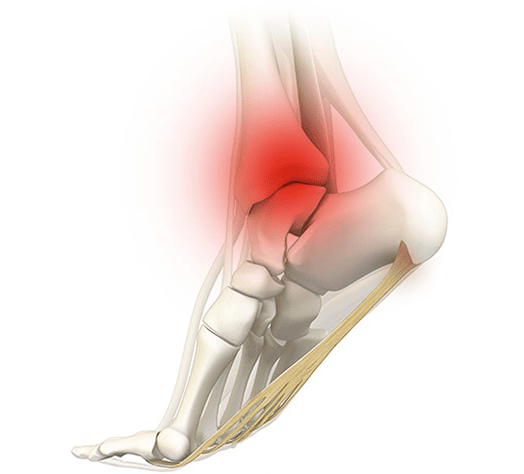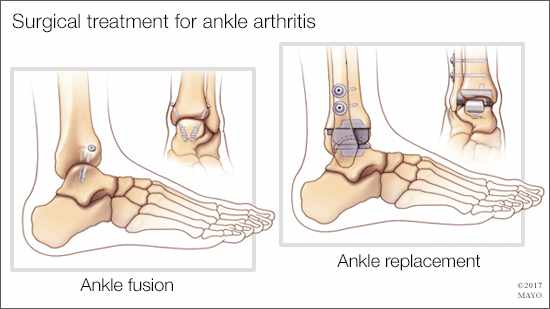
Arthritis of the Ankle Joint
What Is The Problem?
Arthritis of the ankle occurs when the soft cartilage lining of the joint wears out and bone moves against bone instead. This is often painful and the joint usually becomes stiff. You may have pain directly from the ankle or pain upon weight-bearing.
Do I Need To Have Treatment?
If your ankle is not painful then treatment is not recommended.
What Are The Treatment Choices?
Non – Surgical
The first line of treatment is to alter your footwear and try painkillers. Boots are often more comfortable than shoes as they provide more support. An ankle support worn with your normal shoes may also help. Modifying your activities or work so you are spending less time on your feet may also help.

Surgical
The surgical options are either joint fusion surgery (known as arthrodesis) or joint replacement surgery (known as arthroplasty). The main aim of surgery is to reduce your pain and improve your function.
Joint fusion surgery permanently stiffness the ankle joint and will not allow any future movement. Screws, staples or plates are used to hold the bones in position. This can be done by keyhole techniques (arthroscopically) or open surgery. With a fusion you will not be able to wear wellingtons, high heels or play active sports again.
Ankle replacement surgery involves removing the arthritic joint and replacing it with an artificial joint. The aim is to reduce your pain and allow movement at the ankle. Not everyone is suitable for a replacement. If you are young, have ankle instability, significant ankle deformity, previous ankle infections or collapse of the ankle bones
you will not be suitable. Ankle replacement surgery does not have the long term results like hip and knee replacements. There is a chance your replacement may loosen overtime and require revision surgery or conversion to a complex fusion. People are able to gently walk, cycle and swim following this surgery. If you wish to do more vigorous sports then an ankle replacement is not advised.
Surgery can be done under a general anaesthetic (asleep) or regional anaesthetic block (awake). Most require an overnight stay in the hospital. These decisions depend on your health and situation at home. A decision will be made with you.
After the surgery if you have had a fusion or replacement it is likely you will be in a non weight-bearing cast after the surgery until two weeks when the wounds have healed. At this stage your surgeon will advise on your specific post operative plan. Usually following a fusion your ankle needs requires a cast or protective boot for 12 weeks. After an ankle replacement protection is required for 6 weeks. It is important to keep your foot elevated and dry initially to reduce the swelling and help the wound healing. It usually takes a year to recover from the surgery and for your walking style to adapt.
Are There Complications?
With any surgical procedure there is a chance of a complication. Every effort is made to minimise the possibility. The complications include:
Long term pain: For this reason surgery is not done for cosmetic reasons.
Infection/Wound Breakdown: Infections may settle with antibiotics but if serious surgery maybe required.
Swelling: Most swelling resolves but some may have permanent swelling.
Scar pain: A scar can be painful and sensitive. When the wound has healed and is dry, gentle massage with skin moisturise is recommended.
Non Union: The bones may not heal after surgery. The biggest risk for this is in smokers. Further surgery is often required in this scenario.
Mal Union: The bones heal in the incorrect position.
Numbness or Tingling: Usually this resolves but it may be permanent.
Blood clots: The risk of a blood clot in your calf (deep vein thrombosis) or lungs (pulmonary embolus) is rare after this surgery. Please inform the team if you have had one of these previously as this increases your risk.
Ankle replacement Loosening: There is a chance the ankle replacement may become loose and further surgery may be required.
Ankle replacement Fracture: There is a risk of the ankle bones breaking at the time of implant insertion and also later if you have a fall.
